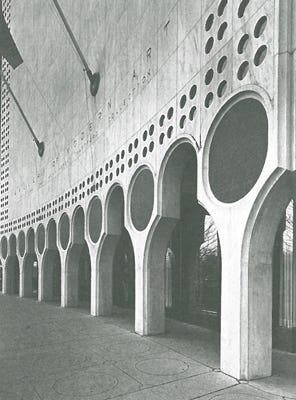
Features
Book Review: Edward Durrell Stone

Edward Durell Stone: Modernism's Populist Architect
by Mary Anne Hunting
W.W. Norton & Co., New York and London; 2013
174 pp; hard cover; more than 200 b&w images; $55
ISBN 978-0-393-73301-3
Reviewed by Clem Labine
Edward Durell Stone (1902-1978) had a fabulous architectural career. At his zenith – in the 1960s – he was arguably the most famous architect in America, with accolades like "colossus" and "visionary" attached to his name. Yet he is largely unknown today except to connoisseurs of architectural history. Stone ran afoul of the mainstream Modernist establishment and as a result, his achievements received only minor footnotes in the official canon of 20th-century American architecture.
Stone's particular sin was his repudiation of the starkness of the International Style in favor of a more romantic architecture that injected ornament and decoration into the Modernist aesthetic. Even though his designs continued to win popular acclaim and clients (a 1968 story in Business Week about Stone was titled: "Man with a Billion on the Drawing Board"), Stone was considered an apostate by Modernist architectural critics and his work after 1945 has been shunned – "kitsch" being a favorite put-down.
The highs and lows of Stone's career are meticulously laid out in this well-researched monograph by architectural historian Mary Anne Hunting. The author hopes this thorough review of Stone's architectural philosophy and output will inspire a more balanced assessment of Stone's place in the pantheon of American architects. The projects documented in this compendium certainly convinced this reviewer that Stone's massive achievements do indeed merit a thoughtful reappraisal.
The young Edward Stone showed considerable aptitude while studying art at the University of Arkansas (1920-23). Becoming attracted to architecture, he moved to Boston to join his older brother who was already an established architect. After two years of study at the Boston Architectural Club (1924-26), he enrolled briefly at Harvard and then transferred to the architecture program at the Massachusetts Institute of Technology, which was still teaching the Beaux-Arts method. His talent was recognized early on, and he won the Rotch Traveling Scholarship (1928-29), which allowed him to tour Europe and sketch historic buildings – creating drawings that were to influence his later work.
Moving to New York upon return from Europe, Stone became part of a consortium of architects working on Rockefeller Center, and had a major hand in the Art Deco interior of Radio City Music Hall. The 1932 exhibition of International Style architecture at the Museum of Modern Art got Stone intrigued with the pure geometry of European Modernism. In 1933 he designed one of the first Modernist homes on the East Coast: the Mandel House in Bedford Falls, NY. Stone's Modernist work soon won him the coveted assignment to design the new home for the Museum of Modern Art (1936-39) in collaboration with Philip L. Goodwin. The museum's crisp marble and glass façade was the most prominent early example of European Modernism in New York and received wide critical approval.
The Shift to Embellished Modernism
With the outbreak of World War II, Stone enlisted in the Army Air Force and spent the duration of the conflict in Washington designing Army Air Force bases. Upon his discharge, he re-opened his New York architectural office in 1945 – but was no longer a doctrinaire European Modernist. His shift towards a more romantic, decorated architecture accelerated in 1953 when he married the vivacious and dynamic Maria Elena Torchio – the American-born daughter of a Florentine architect and a Barcelona mother. The beautiful Maria became his muse, and her Mediterranean background aroused in Stone a wider understanding of architectural beauty and the richness of traditional forms and ornament. (It was also Maria who convinced him to start using his middle name professionally in order to create a memorable three-name "brand.")
The output of Stone's office in the three decades after WWII was truly remarkable in range and quantity, and Hunting provides a well-illustrated overview of his projects, in both the U.S. and foreign countries. His blue-chip commissions included such notable buildings as the American Embassy Chancery in New Delhi, The Kennedy Center in Washington D.C., the General Motors Building and the Huntington Hartford Art Museum in New York, and the Florida State Capitol.
In the mid 1960s, there was no celebrity architect with a name bigger than his. However, Stone alienated the guardians of Modernist orthodoxy when he wrote such things as "I believe the inspiration for a building should be in the accumulation of history" and "Architecture…should be timeless and convey by its very fiber the assurance of permanence." Although the critics and architectural establishment were hostile to Stone's provocative new aesthetic, readers of Traditional Building are likely to be more generous in their judgment of Stone's historically inflected work.
This monograph cannot be called a coffee-table book; its lack of lush full-color photography precludes that dubious honorific. The heavy reliance on historical images – buildings, plans, models and advertisements – dictated the treatise's black-and-white format. What author Hunting has given us is a well-told, well-documented and well-illustrated story of a talented designer's lifelong striving to shape an architecture that satisfied both his inner vision and his clients' desires. Edward Durell Stone was one of the first to show that you don't have to be an austere Modernist to be modern.
Clem Labine is the founding editor of Old House Journal, Traditional Building and Period Homes magazines. He also launched the Palladio Awards program. Labine has received numerous awards including the Arthur Ross Award, the Harley J. McKee Award, and most recently, the Newington Cropsey Award for contribution to the arts. Labine was a founding Board Member of the Institute of Classical Architecture, and served in an active capacity on the board until 2005, when he moved to Board Emeritus status.








